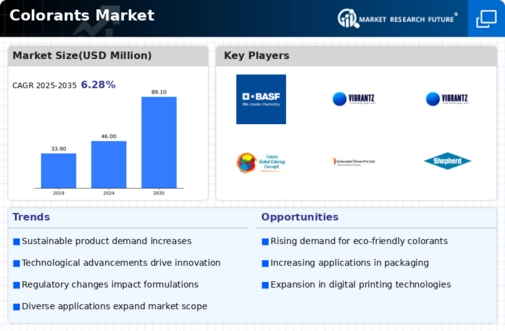Colorants Size
Colorants Market Growth Projections and Opportunities
The colorants market is influenced by several key market factors that shape its dynamics and growth trajectory. One significant factor is the increasing demand from various end-user industries such as automotive, packaging, textiles, and construction. These industries utilize colorants extensively in their products to enhance aesthetics and differentiate their offerings in the market. The growth of these sectors directly correlates with the demand for colorants, driving market expansion.
Moreover, technological advancements play a crucial role in the colorants market. Innovations in colorant formulations and manufacturing processes contribute to the development of high-performance and environmentally friendly products. Manufacturers are continuously investing in research and development to introduce innovative colorant solutions that meet the evolving needs of end-users while complying with stringent regulations regarding environmental sustainability and safety.
Global economic conditions also significantly impact the colorants market. Economic growth in emerging markets fuels industrial activities, leading to increased consumption of colorants. Conversely, economic downturns may dampen market growth as industries scale back production and expenditure. Currency fluctuations and trade policies further influence market dynamics, affecting the pricing and availability of colorants on a global scale.
Environmental regulations and consumer preferences towards eco-friendly products are driving the demand for sustainable colorant solutions. With growing awareness about environmental issues, industries are increasingly adopting organic and natural colorants derived from renewable sources. Additionally, stringent regulations regarding the use of hazardous chemicals in colorant formulations are prompting manufacturers to invest in safer alternatives, thereby shaping the market landscape.
The competitive landscape of the colorants market is another significant factor affecting its dynamics. The market is characterized by intense competition among key players striving to gain a competitive edge through product differentiation, strategic partnerships, and mergers and acquisitions. Companies are also focusing on expanding their product portfolios to cater to diverse end-user requirements and gain a larger market share.
Technological disruptions such as digitalization and the adoption of digital printing technologies are transforming the colorants market. Digital printing offers advantages such as reduced setup costs, shorter lead times, and customization capabilities, driving its adoption across various industries. This shift towards digital printing is influencing the demand for specialized colorants optimized for digital applications, thereby shaping market trends.
Furthermore, shifting consumer preferences and trends in color preferences impact the colorants market. Consumer preferences for vibrant colors, unique effects, and customization options drive the demand for specialized colorant solutions. Manufacturers are continually innovating to introduce new colorant formulations that align with prevailing consumer trends, thereby staying competitive in the market.
Supply chain disruptions and raw material price volatility are additional factors that impact the colorants market. Fluctuations in raw material prices, particularly petrochemical-based colorants, can affect production costs and profit margins for manufacturers. Supply chain disruptions, such as natural disasters or geopolitical conflicts, can lead to shortages or disruptions in the supply of raw materials, impacting the overall market stability.











Leave a Comment